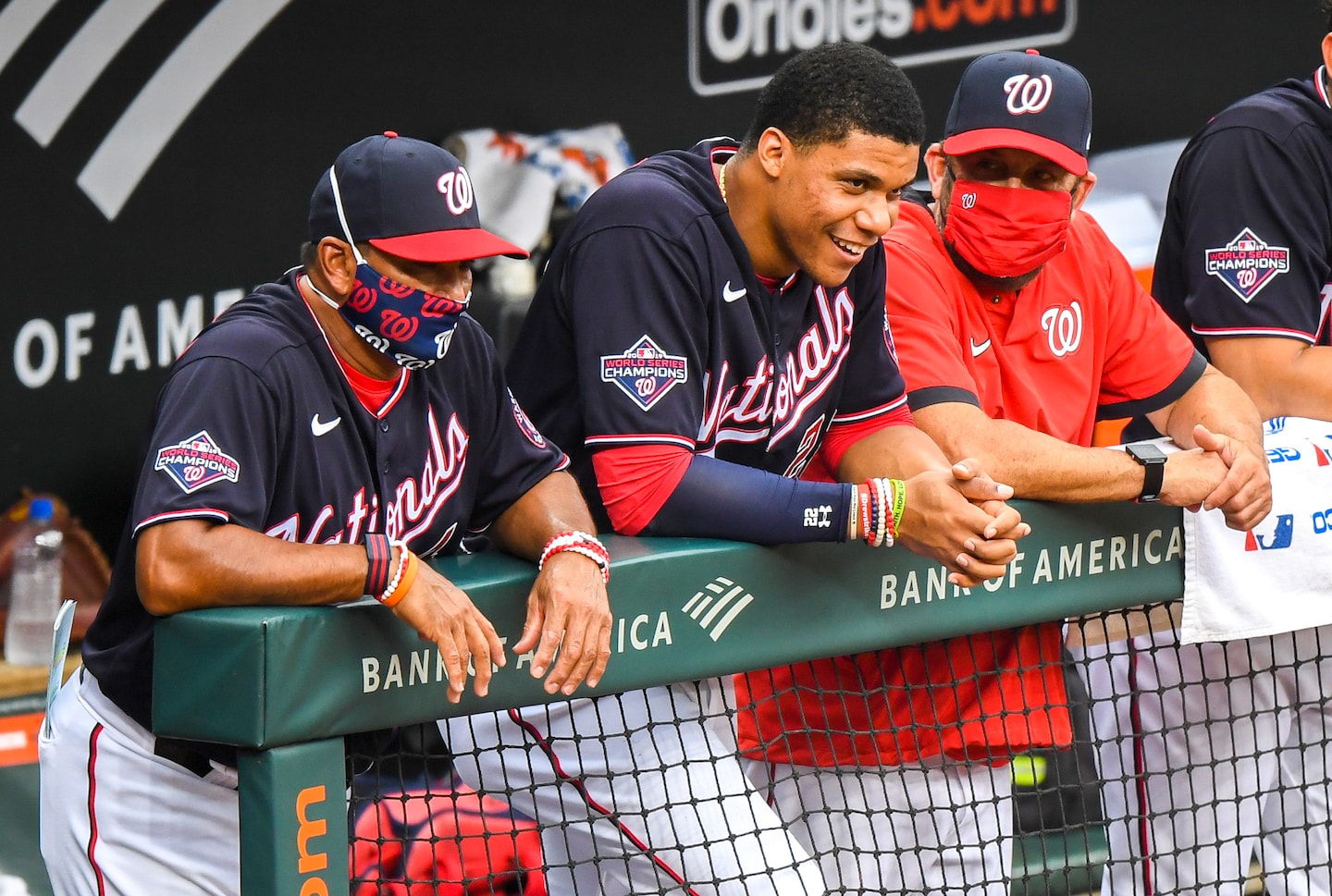Dave Martinez knows baseball has unwritten rules. He also knows the game is evolving.

Their handshake — two high-fives and a lawn mower motion — went viral. Martinez watched and bristled. He soon called Robles and Soto into his office to set some ground rules: celebrate all you want, but do it off the field. When the Nationals got hot in May and began dancing after each home run, Martinez was fine with them goofing in the dugout. He even joked about the ritual with reporters.
This, he thought, was a compromise.
So when asked Tuesday about the unwritten rules of baseball, Martinez called for open dialogue between players and managers. He recognized that two generations are trying to squeeze into the sport’s changing culture. The night before, Fernando Tatis Jr. had hit a grand slam on a 3-0 pitch in a seven-run game. Chris Woodward, the Texas Rangers’ manager, took exception to that, saying: “There’s a lot of unwritten rules that are constantly being challenged in today’s game. I didn’t like it, personally.” It all triggered discussions across the game.
Martinez was briefly Woodward’s teammate with the Toronto Blue Jays. That was back in 2000. And while that may not seem too long ago, Martinez and Woodward grew up in a far different era. They’re regularly reminded of that.
“I know this game has evolved. I’ve learned how to evolve with it,” said Martinez, 55 and in his third year managing the Nationals. “I’ve learned how to deal with different things with young players and stuff. I’ve seen that toward the [end] of my career, how the game was changing. Then when I was coaching I really noticed a big difference. This isn’t a dictatorship by any means. It’s taking individual players and teaching them what you want to try to do and what you want to try to avoid.”
Unwritten rules are tough to follow for obvious reasons. They … aren’t written down. But baseball’s old-school ways are ingrained in managers, coaches, veterans and reporters who have been around the game for a while. One of those ways, as shown this week, is that it is disrespectful to swing at a 3-0 pitch in a lopsided game. Tatis, 21, later told reporters that he didn’t know that. And he grew up in major league clubhouses while his father played for the Rangers, St. Louis Cardinals, Montreal Expos, Baltimore Orioles and New York Mets.
There was a strategic argument in Tatis’s favor. Martinez hinted at it. Seven-run leads aren’t always safe. It was just this past September that the Nationals scored seven in the ninth to stun the Mets, one of their defining wins of a World Series run. But the real push-pull is between young players and the old guard. Active players jumped to Tatis’s defense. Martinez took a nuanced approach, having played in the ’80s, ’90s and early 2000s but now coaching four players 23 years old or younger.
“Would never apologize for going deep 3-0 or any other count,” Howie Kendrick, the Nationals’ 37-year-old utility man, wrote in an Instagram post Tuesday. “We are on the field to play baseball. If you don’t like him going deep 3-0 then don’t get to 3-0.”
“What I worry about is they only see things one way,” Martinez said of his young players, including Robles (23), Soto (21), Carter Kieboom (22) and Luis García (20). “I want them to have a bigger spectrum of what transpires and what goes on. I teach them what went on when I played the game and before me, and what I learned and why they do what they do, why these unwritten rules apply.”
From there, Martinez says, the players “make their own judgment” about how to act. Soto is Exhibit A. The phenom already has seven home runs in his first 13 games this summer. He has also continued a unique plate approach, which Martinez first coined the “Soto Shuffle.” After taking pitches, Soto will do one of a few tics: He’ll kick dirt around the batter’s box, stomp his right foot into the ground and grin, wiggle his hips, take a massive cut through the air, or sometimes grabs his crotch while staring at the pitcher. Soto says it’s for rhythm, but he has mentioned that it’s a way to get in pitchers’ heads. And some pitchers don’t like that very much.
Earlier this month, Mets starter David Peterson hit Soto in the back with a fastball. Soto looked at him, brows furrowed, but didn’t say anything. In his next at-bat, he homered. Then, in Atlanta on Monday, Soto was inching behind home plate to get a look at reliever Will Smith’s warmup pitches. He does that whenever he is the first or second batter of an inning.
But Smith appeared to tell him to “get the f— out of there,” and Soto retreated. He soon took Smith’s first pitch over the left-center field wall, admired it, peered at Smith and had the veteran yelling at him all the while. Replays blurred Smith’s mouth when showing the confrontation. Martinez later recounted what he told the reliever from the dugout, saying: “Just be quiet and get on the mound. You threw the pitch. Make a better pitch.”
“For our guys, they get it,” Martinez said. “Juan does his thing. I told him, I played with a lot of guys a lot worse than what you do up there. That’s just who you are. I know you don’t show anybody up. Just play the game.”
Then Martinez threw all of his weight behind Soto. That’s part of the cultural compromise, too.
“If anything happens, if someone says anything to you, I’ll be the first one to say something back.”






